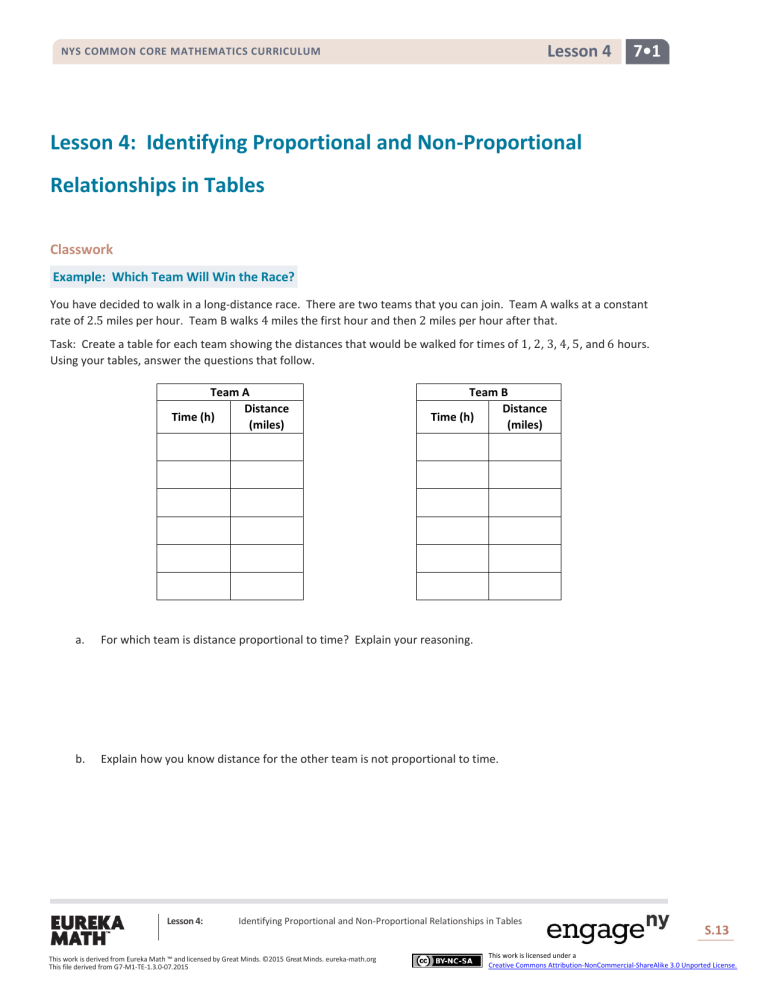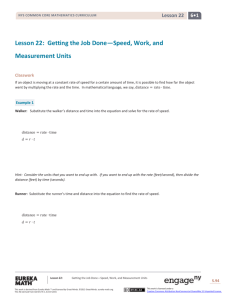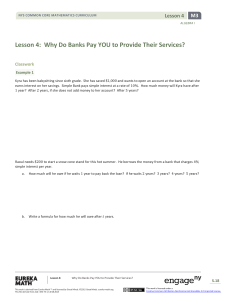
Lesson 4 NYS COMMON CORE MATHEMATICS CURRICULUM 7•1 Lesson 4: Identifying Proportional and Non-Proportional Relationships in Tables Classwork Example: Which Team Will Win the Race? You have decided to walk in a long-distance race. There are two teams that you can join. Team A walks at a constant rate of 2.5 miles per hour. Team B walks 4 miles the first hour and then 2 miles per hour after that. Task: Create a table for each team showing the distances that would be walked for times of 1, 2, 3, 4, 5, and 6 hours. Using your tables, answer the questions that follow. Team A Distance Time (h) (miles) Team B Distance Time (h) (miles) a. For which team is distance proportional to time? Explain your reasoning. b. Explain how you know distance for the other team is not proportional to time. Lesson 4: Identifying Proportional and Non-Proportional Relationships in Tables This work is derived from Eureka Math ™ and licensed by Great Minds. ©2015 Great Minds. eureka-math.org This file derived from G7-M1-TE-1.3.0-07.2015 S.13 This work is licensed under a Creative Commons Attribution-NonCommercial-ShareAlike 3.0 Unported License. Lesson 4 NYS COMMON CORE MATHEMATICS CURRICULUM 7•1 c. At what distance in the race would it be better to be on Team B than Team A? Explain. d. If the members on each team walked for 10 hours, how far would each member walk on each team? e. Will there always be a winning team, no matter what the length of the course? Why or why not? f. If the race is 12 miles long, which team should you choose to be on if you wish to win? Why would you choose this team? g. How much sooner would you finish on that team compared to the other team? Lesson 4: Identifying Proportional and Non-Proportional Relationships in Tables This work is derived from Eureka Math ™ and licensed by Great Minds. ©2015 Great Minds. eureka-math.org This file derived from G7-M1-TE-1.3.0-07.2015 S.14 This work is licensed under a Creative Commons Attribution-NonCommercial-ShareAlike 3.0 Unported License. Lesson 4 NYS COMMON CORE MATHEMATICS CURRICULUM 7•1 Exercises 1. Bella types at a constant rate of 42 words per minute. Is the number of words she can type proportional to the number of minutes she types? Create a table to determine the relationship. 1 Minutes 2 3 6 60 Number of Words 2. Mark recently moved to a new state. During the first month, he visited five state parks. Each month after, he visited two more. Complete the table below, and use the results to determine if the number of parks visited is proportional to the number of months. Number of Months Number of State Parks 1 2 3 23 Lesson 4: Identifying Proportional and Non-Proportional Relationships in Tables This work is derived from Eureka Math ™ and licensed by Great Minds. ©2015 Great Minds. eureka-math.org This file derived from G7-M1-TE-1.3.0-07.2015 S.15 This work is licensed under a Creative Commons Attribution-NonCommercial-ShareAlike 3.0 Unported License. Lesson 4 NYS COMMON CORE MATHEMATICS CURRICULUM 3. 7•1 The table below shows the relationship between the side length of a square and the area. Complete the table. Then, determine if the length of the sides is proportional to the area. Side Length (inches) Area (square inches) 1 1 2 4 3 4 5 8 12 Lesson 4: Identifying Proportional and Non-Proportional Relationships in Tables This work is derived from Eureka Math ™ and licensed by Great Minds. ©2015 Great Minds. eureka-math.org This file derived from G7-M1-TE-1.3.0-07.2015 S.16 This work is licensed under a Creative Commons Attribution-NonCommercial-ShareAlike 3.0 Unported License. Lesson 4 NYS COMMON CORE MATHEMATICS CURRICULUM 7•1 Problem Set 1. Joseph earns $15 for every lawn he mows. Is the amount of money he earns proportional to the number of lawns he mows? Make a table to help you identify the type of relationship. Number of Lawns Mowed Earnings ($) 2. At the end of the summer, Caitlin had saved $120 from her summer job. This was her initial deposit into a new savings account at the bank. As the school year starts, Caitlin is going to deposit another $5 each week from her allowance. Is her account balance proportional to the number of weeks of deposits? Use the table below. Explain your reasoning. Time (in weeks) Account Balance ($) 3. Lucas and Brianna read three books each last month. The table shows the number of pages in each book and the length of time it took to read the entire book. Pages Lucas Read Time (hours) 208 156 234 8 6 9 Pages Brianna Read Time (hours) 168 120 348 6 4 12 a. Which of the tables, if any, shows a proportional relationship? b. Both Lucas and Brianna had specific reading goals they needed to accomplish. What different strategies did each person employ in reaching those goals? Lesson 4: Identifying Proportional and Non-Proportional Relationships in Tables This work is derived from Eureka Math ™ and licensed by Great Minds. ©2015 Great Minds. eureka-math.org This file derived from G7-M1-TE-1.3.0-07.2015 S.17 This work is licensed under a Creative Commons Attribution-NonCommercial-ShareAlike 3.0 Unported License.






